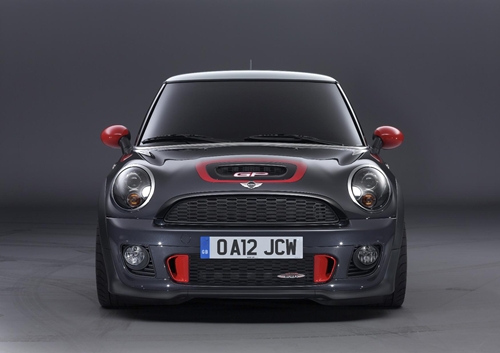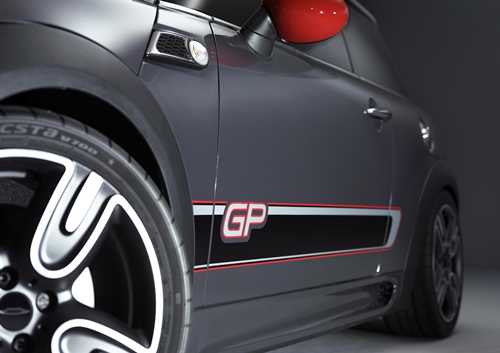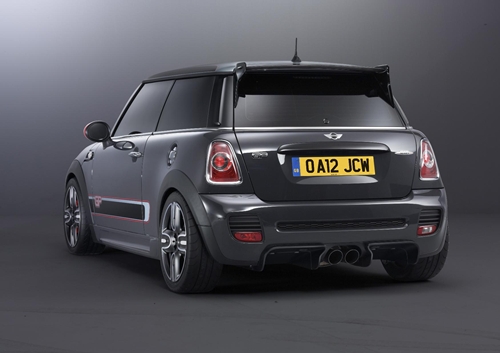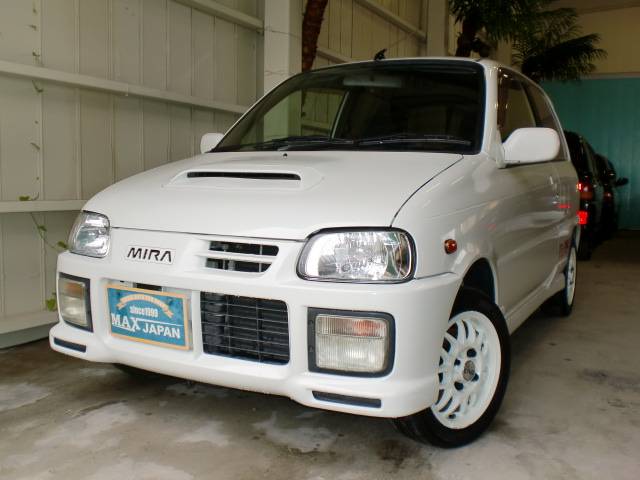Do you remember the
Mitsubishi Evolution FQ 330 that we showed you last week, well that was nothing compared to this, the FQ 400. Whereas the 330 HP version seemed to be nothing more than an
EVO MR with a reflashed ECU, the FQ 400 is a whole different animal.
Starting off with the basics, Mitsubishi’s 4B11 receives four new high-flow fuel injectors, a new hybrid turbocharger that reduces lag, an upgraded intercooler to handle the additional boost and a full 3 inch stainless steel exhaust that spits the spent gasses out of a centrally mounted tail pipe. The result is a peak output of 403 HP and 387 lb-ft of torque. Enough thrust to move the FQ 400 from 0 to 60 MPH in just 3.8 seconds.
Getting back to the “all new animal” topic. The FQ 400 receives a couple of body mods, that not only make the car look as impressive as the old
EVO VI TME, but their composite construction saves some unnecessary weight and makes the factory tuned EVO even more capable. The engine is hidden away by a new hood with larger opening for even better cooling; the front bumper, side skirts, rear bumper and diffuser are all made from lightweight composite material.
Handling is improved because the chassis now sits 30 mm lower to the ground thanks to the new Eibach springs and Bilstein shock absorbers. The FQ wears stylish new 18 inch lightweight alloys wrapped in very sticky Toyo Proxes R1R tires. The wheel and tire package houses the six piston Alcon/Mitsubishi brake calipers and oversized drilled rotors.
One of the most interesting things is that unlike the flappy paddled FQ 330, the 400 HP hot-rod EVO has a clutch pedal. When the Europe only
Mitsubishi Lancer Evolution FQ 400 hits dealerships, expect to pay around £49,999. Even at that price, the FQ 400 offers an outstanding performance/dollar ratio, something that most of the super cars out there cannot.
Press release
The tenth version of Mitsubishi’s iconic Lancer Evolution models has a new performance flagship model to top its range, the Mitsubishi Lancer Evolution X FQ400.
Extreme Evolution
The Mitsubishi Lancer Evolution X FQ400 is the fastest and most extreme version of Mitsubishi’s motorsport derived machine. With 403bhp and 387lb.ft of torque on offer from its advanced, lightweight aluminum 2.0-litre turbocharged MIVEC (Mitsubishi Innovative Valve timing Electronic Control) petrol engine the Mitsubishi Lancer Evolution X FQ400 is able to reach 62mph from standstill in an estimated 3.8 seconds before reaching an electronically limited 155mph – where permitted.
Traction and handling
Ensuring all the Mitsubishi Evo X FQ400’s power is put to good use is Mitsubishi’s sophisticated Super-All Wheel Control (S-AWC) four-wheel-drive system which appropriates power to the wheels that can best use it, giving the FQ400 quite sensational cross-country performance.
The S-AWC system combines a number of electronic systems that both enhance the Mitsubishi Lancer Evolution X FQ400’s performance and safety, with Active Stability Control and Active Center Differential, Active Yaw Control and Sport ABS giving the Mitsubishi Evo X FQ400 incredible cornering ability, traction and grip. Depending on the conditions the driver can select the most suitable set-up for the S-AWC system, three choices – Tarmac, Gravel and Snow – being offered via the wheel-mounted button and displayed in the central instrument binnacle.
Cornering stability
Increasing the Mitsubishi Lancer Evolution X FQ400’s cornering ability even further over its FQ relatives is a wider track and lowered suspension featuring Eibach springs and Bilstein Shock Absorbers. Lightweight 18-inch, nine spoke alloy wheels fitted with Toyo Proxes R1R tires enhance the FQ400’s grip, giving it sharper cornering response on the road and more incisive steering. The enhanced agility and performance is backed by a revised braking system which uses aerospace grade aluminum alloys and floating sealed discs grabbed by high performance pads.
Extreme Power
To achieve the incredible 403bhp from just 2.0-litres Mitsubishi has had to significantly revise the Mitsubishi Evo X FQ400’s advanced powerplant. Motorsport specification high-flow fuel injectors are fitted to the aluminum cylinder head and a new hybrid turbocharger is also fitted. The higher specification turbocharger features low-friction bearings, a high temperature turbine and strengthened thrust bearing to increase response and reduce turbo lag. Feeding the turbocharger cooled air, improving its performance and efficiency, is an enhanced intercooler, while the exhaust’s gasses flow from the engine via a 3-inch diameter high flow stainless steel piping and catalytic converter before exiting through a centrally positioned exhaust.
Mitsubishi has remapped the Engine Control Unit (ECU) extensively with over 500 hours of development time to allow its 2.0-litre turbocharged engine to not just produce its exceptional output but to do so with excellent derivability. The Mitsubishi Lancer Evolution X FQ400’s acceleration is sensational, it pulling hard through the gears regardless of engine revs. With peak torque of 387lb.ft on offer from just 3,500rpm, the FQ400 is just as able to trickle through town traffic as it is taking a rally special stage.
A ‘nod’ to the Evo VI
The Mitsubishi Lancer Evolution X FQ400 looks every bit the rally refugee too, giving a strong ‘nod’ to the styling cues of the legendary Evolution VI, and builds on the already aggressive style of its Lancer Evolution X FQ relatives.
A heavily vented bonnet helps heat escape from the Mitsubishi Evo X FQ400’s turbocharged engine and a new lightweight composite front bumper incorporating Mitsubishi’s trademark ‘Jet Fighter’ grille features carbon-fiber elements on its leading edges. Additional lighting and High Intensity Discharge (HID) lights mark out the FQ400’s nose, its added aggressiveness further enhanced by a 30mm drop in front ride height. Composite side skirts, a re-styled rear bumper with a carbon fiber diffuser, a rear wing incorporating a gurney strip and a roof-mounted ‘Vortex Generator’ all help manage airflow and cooling.
Behind the 18-inch lightweight, nine spoke alloy wheels it’s possible to see the Alcon brakes on the front, while the Toyo Proxes R1R tires underline the Mitsubishi Lancer Evolution X FQ400’s potency with their aggressive ‘cut slick’ tread pattern. Inside, the driver is held tightly against the FQ400’s sensational accelerative, braking and cornering forces in Recaro bucket sports seats, the range-topping Lancer Evolution X also gaining an Mitsubishi Evo X FQ400 liveried handbrake handle and carbon fiber gearknob.
No compromise
Despite its obvious focus the Mitsubishi Lancer Evolution X FQ400’s suspension offers compliance thanks to the Eibach Springs and Bilstein Shock Absorbers, the FQ400’s usefulness as a daily driver not compromised overly thanks to Mitsubishi’s chassis tuning. The stiff bodywork not only provides an exceptionally rigid platform for the suspension to work, but excellent crash-worthiness, the Lancer Evolution X attaining a five-star score in Euro NCAP’s independent crash tests. The Mitsubishi Evo X FQ400’s S-AWC and its incorporated stability, traction and braking systems helping avoid an accident in the first place. Even so there’s reassurance of seven airbags, seat belt pretensioners and ISO Fix child seating all included in its standard specification.
Fully loaded
Standard equipment for the range-topping Lancer Evolution X model is comprehensive, the Mitsubishi Lancer Evolution X FQ400 coming with Bluetooth hands-free telephone connection, a CD-tuner with 30 Gig hard drive, DVD satellite navigation and privacy glass. Convenience features like remote central locking, automatic headlamps and windscreen wipers increase the FQ400’s ease of use, the huge performance it offers not coming at the expense of usefulness. Like its Lancer Evolution X relatives it features comfortable seating for five as well as a usefully sized boot, the Mitsubishi Lancer Evolution X FQ400 bringing all the convenience of the standard saloon car it’s based upon – but with explosive performance potential.
Setting the standard
Standard it’s not though, instead the Mitsubishi Evo X FQ400 is a standard setter, with performance that’s the measure of any rival and many exotic sports and supercars costing many multiples of its £49,999 list price. Available from June 2009, the FQ400 is covered by a three year / 36,000 mile warranty.







